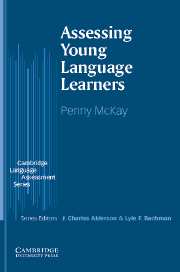Book contents
- Frontmatter
- Contents
- Series editors' preface
- Acknowledgments
- 1 A special case for young learner language assessment
- 2 Young learners and language learning
- 3 Research into the assessment of young language learners
- 4 Assessing language use through tasks
- 5 Classroom assessment of language use
- 6 Assessing oral language
- 7 Assessing reading and writing
- 8 Evaluating young learners' performance and progress
- 9 Testing young language learners through large-scale tests
- 10 The way forward
- References
- Index
- Publishers' acknowledgments
9 - Testing young language learners through large-scale tests
Published online by Cambridge University Press: 04 May 2010
- Frontmatter
- Contents
- Series editors' preface
- Acknowledgments
- 1 A special case for young learner language assessment
- 2 Young learners and language learning
- 3 Research into the assessment of young language learners
- 4 Assessing language use through tasks
- 5 Classroom assessment of language use
- 6 Assessing oral language
- 7 Assessing reading and writing
- 8 Evaluating young learners' performance and progress
- 9 Testing young language learners through large-scale tests
- 10 The way forward
- References
- Index
- Publishers' acknowledgments
Summary
Introduction
In this chapter we will look at the development and use of large-scale tests for young learners. Large-scale tests are externally developed tests that are administered to many learners, usually across school districts or school systems. They are usually standardized, that is, they follow a consistent set of procedures for designing, administering and scoring. Standardization is required when scores will be used to compare individuals or groups. If children take the same test under the same conditions, then the scores in the tests are believed to have the same ‘meaning’ and are therefore comparable.
Large-scale standardized tests are employed for many reasons. They can save time and money as resources are pooled in one place, and efficiencies are maximized through shared development and administration processes. Paper-and-pencil tests, often used in large-scale standardized tests, are easy to administer and score, and are therefore less costly. Standardized tests have credibility when they are developed through research techniques. Facts and figures are impressive and can be reported to the public as evidence of effectiveness. They also have anonymity; schools and teachers do not need to be the bearers of bad news to parents and children but can refer to the impartial third party, the test, to convey a judgment. Lastly, standardized tests have comparability. With standardized test data, one school can be compared with others, locally, regionally and nationally (Jalongo, 2000). Comparable data from large-scale standardized tests provides administrators with what they believe is non-refutable evidence for accountability purposes when other, perhaps more qualitative, evidence is, in their opinion, not acceptable or trusted.
- Type
- Chapter
- Information
- Assessing Young Language Learners , pp. 315 - 351Publisher: Cambridge University PressPrint publication year: 2005



